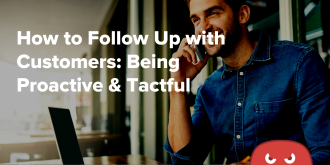Quick Links
Your click-through rate tells you a lot about the effectiveness of your marketing material — whether it’s an ad, email, social media post, or even a website link.
But what, actually, is a good click-through rate? What kind of benchmark should you aim for?
Higher is better, sure, but gains are often marginal and hard-earned. You don’t want to invest substantial resources for a negligible click increase.
In this article, we’ll talk about click-through rates and why they’re important and go over a few broad factors that impact your click-throughs. Then, we’ll look at good click-through targets for the major marketing channels and offer some tips on improving yours.
What is a click-through rate?
Click-through rate, or CTR, measures the ratio of users that click on your links. This is usually applied to advertising campaigns or email outreach. Knowing your CTR can help you gauge the effectiveness of your campaigns.
You determine your CTR by dividing the number of clicks your link receives by the number of impressions. Every time your link is shown to a potential customer, it’s an impression.
Given the same number of impressions, more clicks generally mean that your content is relevant to the target audience. More of those people are compelled enough by the content to click through to the next step.
If you have a lot of traffic already but a low CTR, improving your CTR just slightly could lead to a drastic increase in sales and revenue.
Also, if you start off with a high CTR but a low amount of traffic, scaling properly could help you grow.
What impacts click-through rate?
Factors that impact CTR can vary by the marketing channel you’re using. For example, things that impact email CTR may not apply to PPC ads.
Still, there are a few things that most channels have in common.
Industry
Industry plays a huge role in CTR.
Some industries simply have higher average CTRs than others for various reasons. For instance, differences in the level of competition or the price of the products/services in that industry could be a factor.
Seasonal businesses will also likely see much higher CTRs during their particular season.
Relevance
The more relevant an ad is to the viewer, the more likely they’ll click through.
That goes for keyword relevance, but the relevance of the ad copy (and image, if applicable) can also increase the likelihood of nabbing a click.
You should also make sure that these factors can grab the attention of your audience. Shoot for a high quality score with expertly written relevant content and a striking image that speaks to your target audience.
Device
Your user’s device influences CTR because it changes the format of your content.
For instance, social media smartphone app interfaces look different from their web browser counterparts on desktops.
This is similar to email. The preview text length shown in your subject line can differ between smartphones and computers.
For SEO, Google’s gone mobile-first. In other words, it prioritizes the mobile version of your ad or content for indexing and ranking purposes.
Call-to-action
Ultimately, the call-to-action directs the reader to click. Your CTA’s look and format, along with the copy you use, can impact the number of users that click through.
For instance, making the CTA more prominent and using commanding/action-based language may potentially boost your clicks.
What is a good click-through rate for Google PPC campaigns?
The average CTR for Google search PPC campaigns under Google Ads is 3.17%, according to Wordstream.
Of course, CTRs vary widely across industries.
For instance, that Wordstream study shows that the dating/personals vertical has the highest CTR for search ad campaigns out of all the industries studied at 6.05%. That sector is followed by travel and hospitality at 4.68% and advocacy at 4.41%.
Meanwhile, the tech industry has the lowest CTR at 2.09%. Other low-CTR verticals include B2B and consumer services, both at 2.41%.
Regardless, try to shoot above your industry average.
How to improve PPC click-through rates
Here are a few ways to boost your PPC CTRs:
- Match keywords to search intent: By understanding what your users are searching for and why, you can use keywords that are more likely to resonate with them.
- Improve ad copy: Implementing some persuasion techniques and making the copy and calls-to-action on your search ads more relevant can increase clicks.
- Use Google Remarketing Ads: Existing customers are much easier to sell to. Since they have already bought and experienced your product or service, they have a lot more trust in your business.
- Use Google Ads extensions: These let you show extra business information like your ratings, webpage links, and contact information.
For more help with your PPC ads, check out HOTH PPC.
What is a good click-through rate for SEO campaigns?
It’s hard to say what a good CTR is for SEO campaigns.
However, it’s valuable to know that the first five organic results on Google account for 67.60% of all clicks.
Meanwhile, spots 6–10 represent only 3.73% of all clicks. If you fall onto the second results page, you can say goodbye to any sort of great CTR.
SEO is different from other channels when it comes to CTR. Your search result has to be relevant for the user to rank highly. If it’s relevant, it will naturally get more clicks.
Google’s algorithm is very advanced and tough to trick. There’s little chance of you getting to the top if you aren’t extremely relevant to the user.
How to improve SEO click-through rates
Improving your SEO CTRs mostly comes down to simply improving SEO as a whole. Here are some ways to do it:
- Hone your keyword research: You should regularly research keywords and use that to generate new content ideas.
- Use video: Video helps move you up in the search results, as it can keep people on your site longer.
- Use Google Search Console: This can help you find the best pieces of content to study and see what makes them work well.
- Get backlinks: You can either build or buy backlinks to boost your SEO.
What is a good click-through rate for email?
According to MailChimp data from October 2019, the average email CTR for all industries analyzed was 2.62%.
Once again, industry matters. However, email provides you with more room to add copy and images, so those can play a bigger role in impacting CTR.
Of course, your list matters too. If you’re not getting the right people on your list, your clicks and opens might be lower.
How to improve email click-through rates
Here are some ways to boost your email CTRs:
- Manage your list health: Maintaining list health involves cleaning inactive subscribers off your list. If they aren’t engaging, you might not be relevant to their pains/problems.
- Improve your lead magnet/squeeze page: Making your squeeze page and lead magnet more relevant to your target audience will get more of those customers onto your list.
- Punch up your copy: Improving your email copy will drive more readers to the bottom of the email and get them to click. Emails should be scannable, too.
- Utilize segmentation: Segment your list to ensure different emails are getting to the right people.
- Use A/B testing: Segment your list and send different variations of the same email to each one, and see which performs better.
What is a good click-through rate for social media?
Social media CTRs vary by more than industry — you also have to consider the platform and whether the content is an organic post or paid ad. Each platform has its own format, and users have different search intents.
For instance, LinkedIn is more about networking and looking for jobs. Advertising may not do as well on there as, say, Facebook.
Even within ads, it depends on the type of ad.
For instance, the median CTR for Facebook Ads placed in the newsfeed was 1.11% in Q1 2020.
Meanwhile, Instagram’s newsfeed ad median CTR sat at just 0.22% for Q1 2020. Instagram’s visual focus may hamper CTRs in a way that Facebook doesn’t.
Twitter ads fell between the two at 0.86% CTR.
How to improve social media click-through rates
Here are some tips to improve social media CTRs:
- Hone your headline and copy: Social media users are scrolling fast. You really need to grip their attention and pull them through your ad with compelling copy to succeed.
- Strengthen CTAs: Make sure your CTA has clear instructions on what to do next. Use action words like “download now” or “sign up today.”
- Check your target audience: Improve your targeting by understanding your audience better.
- Use images: Visuals can grab attention much better than text alone.
- Retarget: On Facebook, retargeting lets you show your ads to customers familiar with your brand. If they already know about you, they might be more likely to click — especially if they already bought.
What is a good click-through rate for banner ads?
The average CTR for banner ads on the display network, also called display ads, sits at 0.35%.
As you can see, banner ads tend to have low CTRs relative to many other marketing channels. This may be because some perceive them as “spammy” and are afraid to click on them for fear of getting a virus.
How to improve banner ad click-through rates
Here are some ways to improve banner ad CTRs:
- Use long-tail keywords: Long-tail keywords have lower search volume but are much more targeted and relevant to that smaller number of searchers.
- Evaluate and cut out certain sites: Monitor which sites your ads perform the worst on, and cut those out if possible.
- Analyze device use: Users of certain devices may be clicking on your ads more than others. Investigate and determine if you should double-down on certain devices.
Don’t get too focused on click-through rate
The general rule is that a higher CTR creates positive results for your business.
But as with any rule, there are exceptions. Focusing on CTR to the exclusion of other things can be unproductive at best and counterproductive at worst by harming your conversions.
For instance, you could write a “clickbait” type of ad that makes wild claims about a result your customers can achieve. They click through to the landing page, and it’s much more underwhelming than the ad sounded.
That loses a customer’s trust and interest, so they click away. The sale is totally lost, and the poor experience could even harm your brand if that customer tells others about it.
Another example would be scoring a high CTR on irrelevant keywords. Like the previous example, the user will be disappointed by the lack of relevance once they click the ad.
Thus, you end up wasting money.
Ultimately, CTR doesn’t matter without conversions.
Get more clicks for your money
There’s no definitive “good” click-through rate. Striving for the industry standard is a good rule of thumb, but there are plenty of other factors at play.
That said, blindly working hard on improving CTR without considering the consequences can be detrimental. You have to put CTR into context — increasing it is good as long as the ad, email, and post/landing page that follows is relevant to the reader.
It’s a better idea to find your current CTR and test ways to improve it instead of striving relentlessly for an arbitrary number.
That’s something we can help you do, especially with PPC campaigns. Schedule a call if you want help boosting your CTRs, and more importantly, conversion rate and sales.












